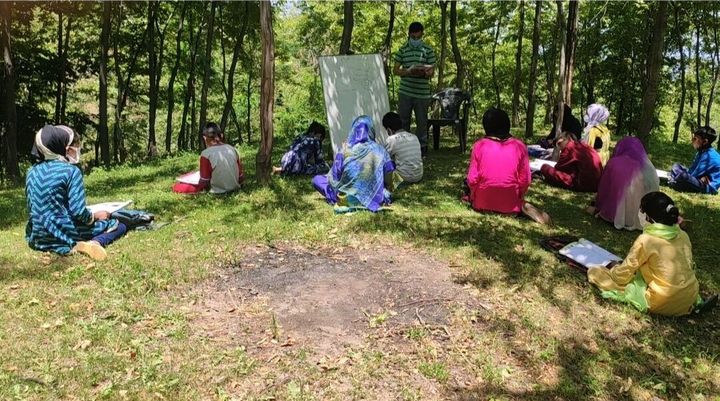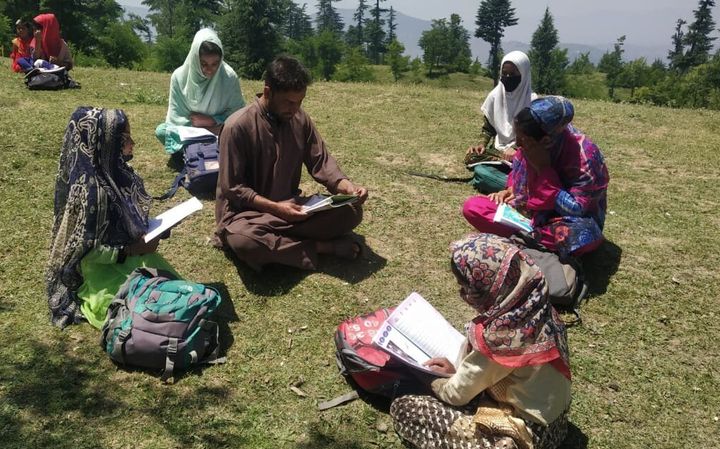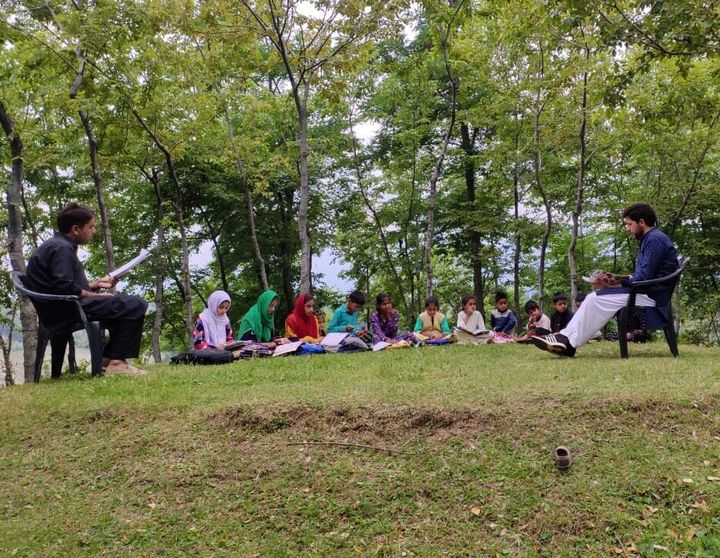
BARAMULLA, Jammu and Kashmir — The last time that Parvez Ahmad Famda, a 39-year-old primary school teacher in Kashmir, saw the inside of a classroom was on 12 March. The 15 fifth graders he teaches were all in attendance.
Four months on, Famda is once again dreaming of teaching in a classroom — the Covid-19 lockdown forced schools to shut again within two weeks of reopening for the first time since Jammu and Kashmir’s special status was rescinded in August last year.
“First, there was the long communication blockade and now this pandemic lockdown. It haunts me when teachers are not able to deliver on our duties because of our circumstances,” he said.
The end of the lockdown imposed by the Narendra Modi government after it abrogated J&K’s special status on 5 August, 2019, was followed by a second one that it imposed on 25 March, 2020, this time across India, to try and stop the spread of the coronavirus.
There was a close to six-month long ban on the internet from 5 August before it was restored on 25 January, following an international outcry over the longest internet ban imposed by a democratic country. The ban was replaced by a slow 2G network that has upended online teaching.
The government school where Famda teaches in district Baramulla closed from 5 August, 2019 till 24 February, this year. The school remained open for 17 days before it was closed from 12 March due to a pandemic, almost two weeks before the nationwide lockdown.
Frustrated by this, Famda, a father to two children, has for almost a month been teaching at an open-air school that he along with seven more teachers from three different government schools set up in Katainwali, a village nestled in the hills of Baramulla.
Sitting in the shade of trees, surrounded by over a dozen students and a stunning vista of the hills, Famda says he wants to make sure that children do not completely forget the joys and rigours of school.
“At the very least, they need to stay in touch with their books amid the Covid-19 lockdown,” he said.
According to the Directorate of School Education Kashmir, close to nine lakh students are enrolled in 10,915 government schools in Kashmir, and close to six lakh students are enrolled in 2,744 private schools in the Kashmir Valley. Director School Education, Kashmir, Muhammad Younis Malik, told HuffPost India that there are around 70,000 teachers in government schools in Kashmir.
HuffPost India spoke to Famda, who has been teaching primary school students since 2004, about what it’s like to be a teacher in a conflict zone, in the middle of a coronavirus pandemic, with only 2G internet in his arsenal.
“When we started the community school, I asked students to write with a pencil. Most of the children below the age of 10 could not hold a pencil properly,” he said. “I could see how the prolonged lockdown was hurting these children who were not even able to hold a pencil properly.”
“Most of the children below the age of 10 could not hold a pencil properly.”
What is it like to be a teacher in Kashmir right now?
Teaching is a challenge in Kashmir. When doctors treat patients, they prescribe medicines for a specified time. Similarly, children have to go through a process for the whole year and only then can they learn and compete in examinations. But in Kashmir, educational institutions often remain shut due to turmoil and now the pandemic. It becomes very difficult to recover losses and bring children back on track. A teacher also has to work under a system. But when there are interruptions, a teacher goes to the classroom after weeks. Once he loses track, he forgets where he ended and what he has to teach in the future. It becomes difficult to gauge what the students have learnt.
In any profession, not being able to deliver becomes a big challenge. A teacher wants to fulfil his duties by teaching students. Not being able to deliver is a dissatisfying thing for a teacher.
When was the last time you taught in the classroom?
It was in February and March for a few days. I taught students in the classroom at the primary school here when schools reopened on 24 February after around six months and remained open till 12 March.
How did it feel going back to school for a few days?
It was a great moment for both students and teachers when we met after months in the classroom. But that joy remained short-lived as after two weeks, the COVID-19 lockdown began. We had started to make an academic plan but could not deliver due to pandemic.

What happened over the past one year since last August?
It was a difficult task for a teacher to reach out to students when there was no communication for weeks after 5 August. The Valley was shut for months. Making up for these losses is a difficult task for a teacher. I teach primary classes, so I have to groom a student mentally as well as physically. For the past one year, I feel very sad as I am not able to deliver. It haunts me when teachers are not able to deliver on our duties because of the situation.
The internet was restored in January this year but it was 2G.
We started taking online classes for students. However, students were not able to study online in Kashmir due to 2G internet speed. Only a few students were able to attend online classes. Less than half of students have smartphones in this village while for rest it was not possible to attend online classes.
(According to media reports, Kashmir has more than 20,000 broadband connections and has nearly 66 lakh mobile phone subscribers).
Then came the coronavirus lockdown.
We started taking online classes but once again it was difficult for students to comprehend due to low internet speed. Then, eight teachers of this village started a community school. Getting the children out of their homes was also a challenge. We involved the panchayat members to convince the students to attend the community classes. When we started the community school, I asked students to write with a pencil. Most of the children below 10-years-old could not hold pencil properly. I could see how the prolonged lockdown was hurting these children who were not even able to hold a pencil properly.
Any catastrophe - natural or manmade, political or a health crisis, all have an impact on children’s minds. These things occupy their mind. We also engage students in various activities like making them aware about coronavirus and how to protect themselves from this virus by wearing masks and frequently washing hands.
“It haunts me when teachers are not able to deliver on our duties because of the situation.”
How old are these students? Are they of different ages? How do you divide them?
Around 200 students of this village are studying in three government schools. They are below 16. We divide them on the basis of the class they study in. There are maximum 12 students in one class at one place.
What do you teach these students?
We teach them as per the syllabus. We give them home assignments and also take internal assessment examinations. We have decided to continue the community school till schools are not reopened in Kashmir. We can’t compare this with formal schooling because the classroom environment is missing but still we are able to deliver 80% in community schools.
How do you ensure social distancing?
We take classes in the open air. Classes are taken at four different locations in the first half and four locations in the second half in a day. We take maximum 12 students in one class.
What is the real purpose of this community school?
Education is not limited to the syllabus. A teacher student relationship can be best established when they interact face to face whether it is in a classroom or in the open air, not online classes. The daily interactions improve the skills of students and equally help teachers to grow.
What was the most difficult thing about the last year as a teacher professionally?
We are missing the environment that students get in other parts of the country. How can we expect our students who have slow internet to compete with other students of the country? Our system is not working properly because of the turmoil and we as teachers are not able to give desired results.

What was the most difficult thing about the last year, personally?
Everyone has been affected by the past one year. It was difficult staying at home without any means to communicate. I have observed how this lockdown has affected my children. They fight on small things. It becomes difficult to control children at home. There are times when I get aggressive about why they are wasting a lot of their time.
Has there been any interruption in your salary? How do you survive income-wise?
I am receiving my monthly salary from the government.
Tell us about your family. Are they supportive of you being a teacher?
I live with my wife and two children aged 11 and 12. My wife has been very supportive for being me as a teacher. It was she who motivated me to start community school. She told me that since I am getting a government salary, why can’t I teach students in community school. Setting up community school was not possible without the support of my family.
There are always disruptions in Kashmir. But how does last year compare in terms of previous years?
While in previous years, there were disruptions but educational institutions would remain at least open for half of working days. But for the last one year, it has been really a difficult phase for everyone and students lost so much of precious time.
Why did you decide to become a teacher?
It is the teacher who builds a society. I have done my Masters in Sociology. I also have a Bachelor of Education (BEd). I teach all subjects in primary school. But teachers these days don’t get that much respect in society. This could be because teachers are not giving desired results. But teaching is a noble profession and it is my aim to serve the society.